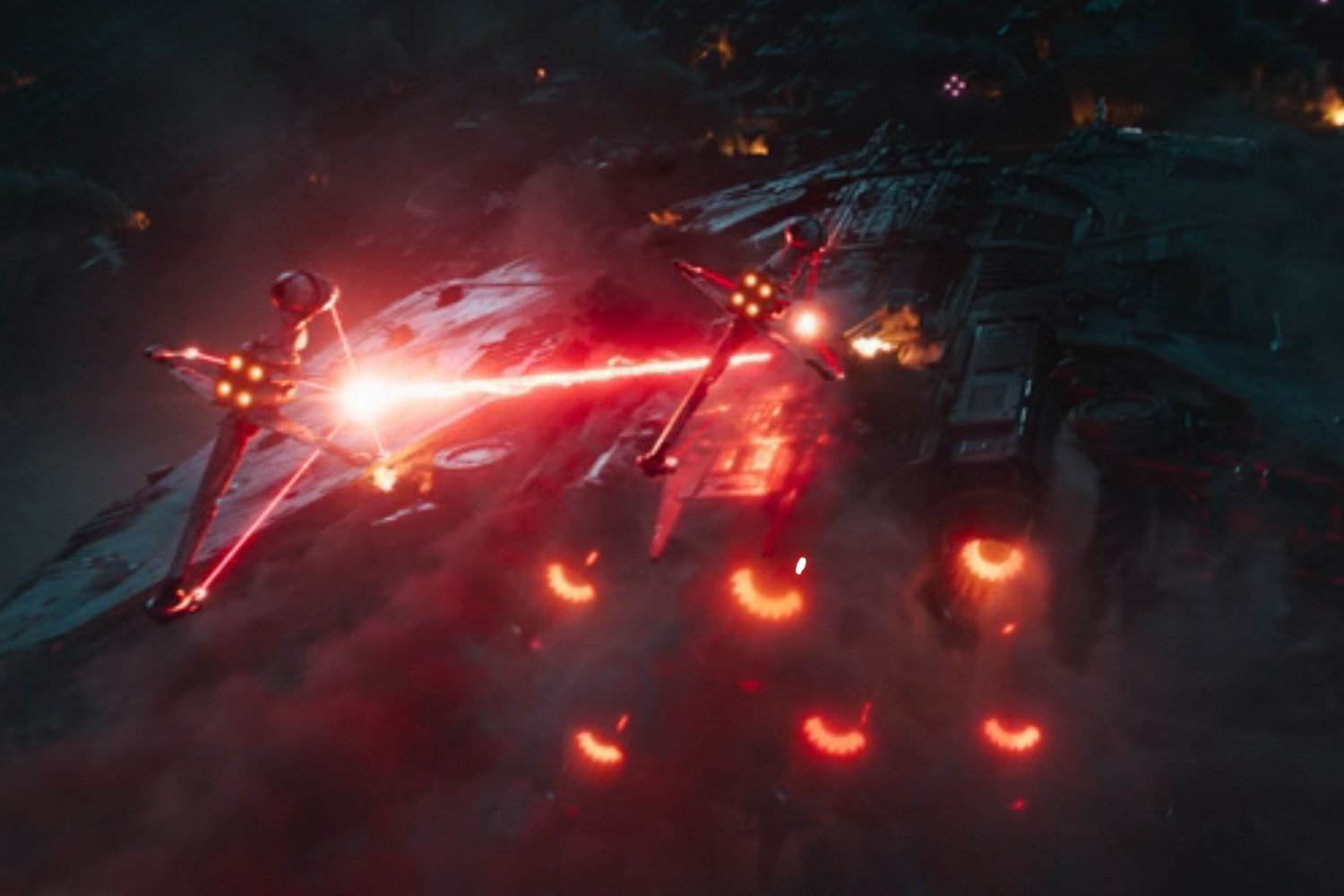The season finale of Skeleton Crew brought something with it fans have been wanting to see since Return of the Jedi: a B-Wing bomber actually doing something. The fabled alphabet fighter has long been a stalwart of Star Wars games, novels, and comics, but it took over four decades to actually see one in live-action taking shots in battle. And yet, for all the excitement, you might have been a bit surprised as to how Skeleton Crew‘s B-Wings opened fire—because it has a much more recent origin story than the B-Wing itself does.
A Brief History of B-Wing Weaponry

A hybrid assault starfighter and heavy bomber, the B-Wing has always been considered one of the most heavily equipped fighters in the Alliance fleet. We never actually saw them in action in Return of the Jedi—the fighter model’s thin profile made it particularly difficult to shoot on bluescreen, meaning many planned shots using the new ship were ultimately cut from the film. After their entrance shot at the Battle of Endor and the scenes of the Rebels pivoting away from the still-operational Death Star II, B-Wings barely appear in the final film at all.
This left ancillary material—most notably the early Star Wars roleplaying game, and then in the ’90s and early aughts video game series like X-Wing, TIE Fighter, and the Rogue Squadron games, to fill in the gaps of what made the B-Wing stand out among the Rebel arsenal. The answer was mostly lots of firepower—if the X-Wing was a jack-of-all-trades craft, the A-Wing a speedy dogfighter, and the Y-Wing explicitly a heavy bomber, the B-Wing operated in the niche of a heavy starfighter designed to punch above its weight class and target capital ships. The tips of each of its S-Foils, as well as two blaster emplacements below its cockpit gave the starfighter a robust arsenal of both heavy laser cannons and, crucially, disabling ion weaponry that would allow the B-Wing to lance through larger vessels with volleys of fire that could penetrate ship systems and shielding. A B-Wing could then follow through with a complement of explosive ordnance, in the form of multiple proton torpedo launchers or space to carry even more devastating payloads.
Enter the Blade Wing

In the Star Wars expanded universe, both the B-Wing and A-Wing were introduced as ships manufactured by the Alliance and its allies after the Battle of Yavin—the B-Wing in particular was developed with the aid of the then-newly recruited Gial Ackbar as part of “Project Shantipole,” seen as a need for the Alliance to upgrade its fighter compliment as the Empire responded to the Death Star’s destruction at the hands of a starfighter wing with increased production of capital ships. This was in part an in-universe explanation as to why neither fighter appeared during the events of A New Hope or Empire Strikes Back, but when Star Wars continuity was rebooted in 2014, both vessels were introduced into the Rebel fleet earlier in the timeline. The A-Wing debuted first during the climax of Star Wars Rebels‘ first season as the primary starfighter of the Phoenix Squadron, the rebel cell that ultimately recruited the series’ heroes into the nascent alliance, but the B-Wing got its own dedicated introduction in Rebels season two’s “Wings of the Master”.
In some ways, the B-Wing was introduced out of a similar necessity—a lack on the rebels’ part of ships with the firepower to punch through blockades of capital ships—but otherwise its origins were radically overhauled. With no Ackbar to be found, he was replaced by Quarrie, a lone Mon Calamari engineer working in secret on a prototype B6 starfighter, dubbed the “Blade Wing.” Shantipole was no longer the name of the project and research station that birthed the ship, but the planet he hid on. Instead of a vessel designed in tandem with the Alliance’s top brass, it was now a single ship, earned through negotiation on the part of Hera Syndulla, that would eventually lay the groundwork for the development of the B-Wing on a larger scale.
Oh, and it also had a big-ass laser beam. Although the Blade Wing still retained individual blaster hardpoints for traditional ion and laser weaponry at the tips of its s-foils as it had in the expanded universe, Rebels introduced the composite beam laser as the Blade Wing’s primary anti-capital-ship weapon: a quad-linked heavy weapon that could drain power from the Blade Wing’s installed hyperdrive to charge and fire a short-ranged targeted beam capable of piercing deflector shields and hull plating.
Following the successful test run of the ship running point-defense for a Phoenix squadron supply run to the blockaded world of Ibaar, Senator Bail Organa secured a shipyard for both Quarrie and the Blade Wing, leading to iteration on the design as the large-scale manufacturing of the B-Wing begun. But in iteration, the composite beam was seemingly scrapped from the final design, alongside the secondary gunner position at the opposite tip of the Blade Wing’s main wing… up until the weapon’s appearance in Skeleton Crew this week, that is.
Want more io9 news? Check out when to expect the latest Marvel, Star Wars, and Star Trek releases, what’s next for the DC Universe on film and TV, and everything you need to know about the future of Doctor Who.
